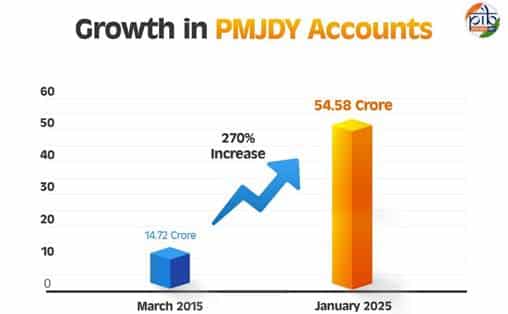Boosting Financial Inclusion and Entrepreneurship

Financial inclusion is a cornerstone of economic development. It aims to provide banking, credit, and insurance services to those who are unbanked or underserved. In India, the government has prioritized this initiative through various schemes. Programs like the Pradhan Mantri Jan Dhan Yojana (PMJDY) and Atal Pension Yojana (APY) are designed to empower individuals and promote entrepreneurship. The motto, “From Jan Dhan to Jan Suraksha,” reflects the vision of achieving financial security and inclusive growth for all citizens. These transformative schemes not only enhance access to financial services but also foster a culture of entrepreneurship among marginalized communities.
Pradhan Mantri Jan Dhan Yojana (PMJDY)
Launched in August 2014, the Pradhan Mantri Jan Dhan Yojana (PMJDY) aims to integrate the unbanked population into the formal financial system. The initiative focuses on expanding access to savings accounts, credit, remittance, insurance, and pensions. Over the years, PMJDY has significantly empowered weaker sections of society and low-income groups. According to the World Bank’s Global Findex Database 2021, bank account ownership in India surged from 35% in 2011 to 78% in 2021.
The achievements of PMJDY are noteworthy. The number of accounts opened under this scheme grew from 14.72 crore in March 2015 to an impressive 54.58 crore by January 15, 2025. Additionally, deposits in these accounts increased from ₹15,670 crore to ₹2,46,595 crore in the same period. The issuance of RuPay cards has also seen a significant rise, with 37.29 crore cards issued to PMJDY account holders by January 2025. This growth in account ownership and financial literacy has laid a strong foundation for economic integration and financial stability among the previously unbanked population.
Atal Pension Yojana (APY)
The Atal Pension Yojana (APY) was launched on May 9, 2015, to provide social security to workers in the unorganized sector. This scheme aims to ensure financial stability for the poor and underprivileged. It is regulated by the Pension Fund Regulatory and Development Authority (PFRDA) and operates under the National Pension System (NPS) framework. The APY has gained traction since its inception, with enrolments rising from 1.54 crore in March 2019 to 7.33 crore by January 2025.
The progress of APY in the current financial year (2024-25) has been remarkable, with over 89.95 lakh enrolments recorded. This growth indicates a rising awareness of the importance of pension schemes among the workforce in the unorganized sector. By providing a safety net for individuals, the APY not only enhances financial security but also encourages savings and investment among low-income groups. The scheme’s success reflects the government’s commitment to improving the financial well-being of its citizens, particularly those who have been historically marginalized.
Pradhan Mantri Jeevan Jyoti Bima Yojana (PMJJBY) and Pradhan Mantri Suraksha Bima Yojana (PMSBY)
Launched on May 9, 2015, the Pradhan Mantri Jeevan Jyoti Bima Yojana (PMJJBY) is a government-backed life insurance scheme aimed at expanding insurance coverage in India. Before this initiative, only 20% of the population had access to life insurance. PMJJBY offers one-year renewable life insurance that covers death from any cause. As of January 15, 2025, enrolments under this scheme have surged from 3.1 crore in FY 2016-17 to 22.52 crore. The scheme has also disbursed ₹17,600 crore against 8,80,037 claims, demonstrating its effectiveness in providing financial security to families.
Similarly, the Pradhan Mantri Suraksha Bima Yojana (PMSBY), launched on the same day, focuses on accident insurance. It covers death and disability, providing a one-year renewable policy for individuals aged 18-70. As of January 15, 2025, PMSBY has recorded 49.12 crore cumulative enrolments, with ₹2,994.75 crore disbursed against 1,50,805 claims. Both PMJJBY and PMSBY have played a crucial role in increasing insurance penetration in India, ensuring that more people have access to essential financial protection.
Stand-Up India Scheme and Pradhan Mantri Mudra Yojana (PMMY)
The Stand-Up India Scheme, launched on April 5, 2016, aims to promote entrepreneurship among women and marginalized communities, including Scheduled Castes (SC) and Scheduled Tribes (ST). The scheme provides bank loans ranging from ₹10 lakh to ₹1 crore for greenfield enterprises in various sectors. By easing financial barriers, it empowers aspiring entrepreneurs to start their businesses. As of July 2024, the loan amount sanctioned under this scheme increased from ₹3,683 crore in March 2018 to ₹53,609 crore, benefiting 2.36 lakh entrepreneurs.
In addition, the Pradhan Mantri Mudra Yojana (PMMY), launched on April 8, 2015, supports small and micro enterprises with loans up to ₹10 lakh. The loan limit was recently increased to ₹20 lakh in the Union Budget 2024-25. PMMY has facilitated financial inclusion by refinancing micro units and empowering aspiring entrepreneurs. As of January 2025, ₹32.36 lakh crore has been sanctioned for 51.41 crore loans, with 68% of loans going to women and 50% to SC/ST/OBC categories. These initiatives reflect the government’s commitment to fostering entrepreneurship and economic growth among underrepresented groups in society.
Observer Voice is the one stop site for National, International news, Sports, Editor’s Choice, Art/culture contents, Quotes and much more. We also cover historical contents. Historical contents includes World History, Indian History, and what happened today. The website also covers Entertainment across the India and World.

